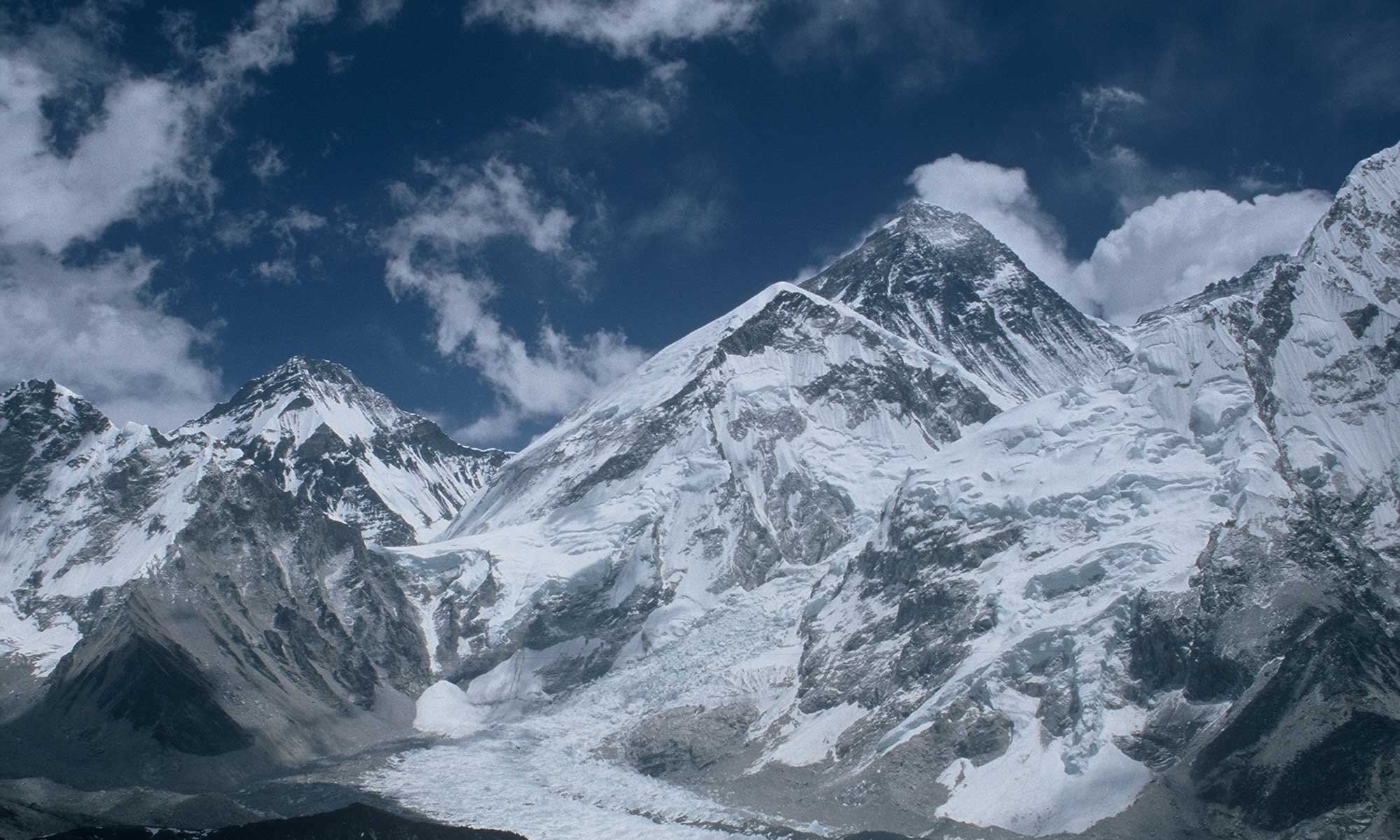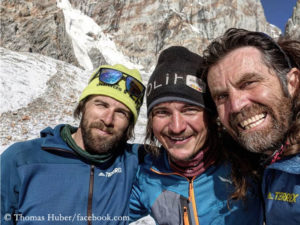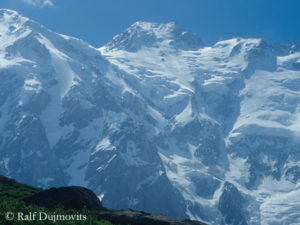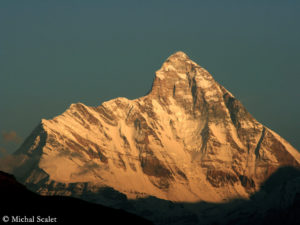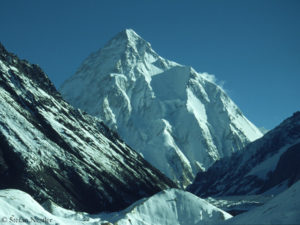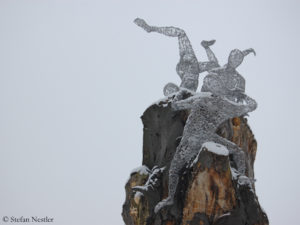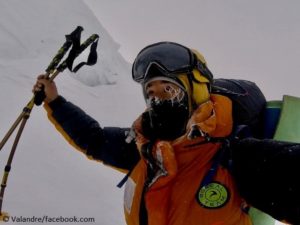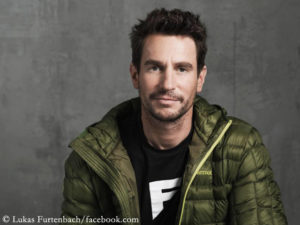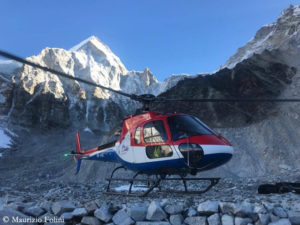He’s almost at the final goal of his dreams. Last Sunday, the South Korean Kim Hong-bin reached with his compatriots Cho Cheol-hee and Cheong Ha-young, the Nepalese Pechhumbe Sherpa and the Pakistani Muhammad Hussain the 8080-meter-high summit of Gasherbrum I in the Karakoram. It was Kim’s 13th eight-thousander success. To complete his collection, the 54-year-old still has to scale Broad Peak. In this case, Kim would be the first disabled mountaineer to stand on all 14 eight-thousanders. Since 1991 he has been climbing without all ten fingers.
Continue reading “Kim Hong-bin: Without fingers on 13 eight-thousanders”K2: Equal distribution on two routes
The teams at the second highest mountain on earth have sorted themselves. As Herbert Hellmuth, German climber in the team of the Nepalese expedition operator “Seven Summit Treks” wrote me yesterday from the base camp, the summit candidates are distributed quite evenly on the normal route via the Abruzzi Spur and the Basque route (often also called Cesen route).
Herbert had a look around the base camp: Of the 120 climbers with permits (75 international mountaineers, 45 Climbing Sherpas from Nepal – they are spread over ten teams) 64 want to climb the Abruzzi route, 56 the Basque route. The Pakistani High Altitude Porters do not appear in this calculation as they do not need a permit. Around ten climbers who had granted a permit had already left the mountain, Herbert writes me: “All in all not such an overcrowded year.”
Continue reading “K2: Equal distribution on two routes”Thomas Huber before his expedition to Choktoi: “Open for all mountains”
“I don’t go to the mountains for social media, I go to the mountains to climb,” Thomas Huber tells me. “In this regard I’m old school.” The 52-year-old, the older of the two Huber brothers, wants to report only after his return from the Karakoram what he and his two companions have experienced. On Monday he will leave for Pakistan along with the 34-year-old South Tyrolean Simon Gietl and the Frenchman Yannick Boissenot. Thomas doesn’t want to talk about the exact destination, he only reveals that they head for the mountains around the Choktoi glacier. In summer 2018, the trio – then accompanied by Rainer Treppte – had set out to climb the still unmastered North Face of the 7,145-meter-high Latok I, but had been unable to enter the wall due to the great danger of avalanches.
Thomas, can I say that the mountains at the Choktoi glacier have become something like your second living room?
Continue reading “Thomas Huber before his expedition to Choktoi: “Open for all mountains””First ascent by Simon Messner, furthermore summit success on Broad Peak
He‘s a chip off the old block. Simon Messner, 28-year-old son of the legendary South Tyrolean climber Reinhold Messner, says he succeeded the first ascent of the 6,200-meter-high Toshe III in the Karakoram last Saturday. The widely glaciated Toshe mountain range lies about 18 kilometers as the crow flies southwest of the eight-thousander Nanga Parbat. Simon climbed in a style that should please his 74-year-old father.
Light and fast
“Due to the difficult snow conditions, the warm temperatures and the very unstable weather I decided to climb the mountain in a single solo push from Advanced Base Camp (at approximately 4,600m),” Simon Messner writes on Facebook: “The plan was to climb light and fast to avoid the bad weather coming up and although I had to track every single meter I reached the summit at 9:30 am (needing 5,5h in total).” The avalanche risk on the descent was high, according to Simon, but he was able to reached the base camp on the same day.
Continue reading “First ascent by Simon Messner, furthermore summit success on Broad Peak”Summit successes on Nanga Parbat
Wednesday was a successful summit day on the eight-thousander Nanga Parbat. Several groups that had formed a large group during their summit push reached the highest point at 8,125 meters. The data from their GPS trackers confirm the summit successes of the Spaniard Sergi Mingote and the mountaineer Stefi Troguet from Andorra.
Sergi Mingote scaled Nanga Parbat without bottled oxygen – after Lhotse in spring it was his second eight-thousander this year he climbed without breathing mask. “Happy!!!”, Sergi let us know about his emotional state via Facebook. Last spring, the 48-year-old had originally wanted to climb Mount Everest after Lhotse, but after an in the end futile rescue operation for the Bulgarian Ivan Tomov (who died, apparently of an high-altitude cerebral edema) he decided not to do so. In 2018, Mingote had reached the summits of three eight-thousanders without bottled oxygen: K2, Broad Peak and Manaslu. This summer, after having scaled Nanga Parbat now, he has set his sights on Gasherbrum I and Gasherbrum II.
Continue reading “Summit successes on Nanga Parbat”Wanted: The Everest Pinocchio test
Oh, if only all the Everest climbers were Pinocchios! Then it would be very easy to distinguish the liars from those who tell the truth. We’d just have to watch – as with the legendary title character of Carlo Collodi’s children’s book – if their noses had become longer, and we’d have caught the culprits. Also this spring some Everest climbers would have got longer noses.
The Indian female climber Vikas Rana and her male compatriots Shobha Banwala and Ankush Kasana claimed to have reached the highest point at 8,850 metres at 10.30 a.m. on 26 May. According to the newspaper “The Himalayan Times”, however, the trio was sighted more than 3,300 meters lower only two hours later: back at base camp. To do this, they would have had to get wings. Other climber reported that the trio did not make it above Camp 3 at about 7,150 meters. On 26 May, a strong wind blew on the summit of Everest. Only a day later did a larger team reach the highest point again.
Continue reading “Wanted: The Everest Pinocchio test”Seven dead climbers recovered in the Indian Himalayas
Ten mountain rescuers of the Indian-Tibetan border police have recovered seven bodies near the seven-thousander Nanda Devi in the Indian Himalayas. They were buried under a metre and a half of snow, a representative of the Indian authorities said. The search for an eighth climber will continue. As reported, the group led by the experienced British expedition leader Martin Moran had been missing since the end of May. The mountaineers had tackled a 6,477-meter-high mountain not far from the 7,434-meter-high Nanda Devi East.
A few days after contact with them had broken off, the crew of a rescue helicopter had discovered five bodies in an avalanche cone on the west ridge of the mountain. The search had to be interrupted due to new heavy snowfalls and therefore high risk of avalanches. Moran Mountain had contradicted the authorities’ accusation that the group had made their way to the unclimbed six-thousander without permission. According to the British expedition operator, the permit applied to all peaks which could be reached from Nanda Devi East Base Camp.
Continue reading “Seven dead climbers recovered in the Indian Himalayas”Nirmal Purja: “I still want to summit all Pakistani 8000ers before the end of July”
Nirmal, called “Nims” Purja has not lost his optimism yet. “We are making progress, the project is still on and I will complete it within my seven-month goal,” the 36-year-old Nepalese posted on Twitter these days. In seven months Nims wants to have scaled all 14 eight-thousanders. In the spring season in Nepal everything went according to plan. Within a month and a day he stood on the summits of six eight-thousanders: Annapurna (23 April), Dhaulagiri (12 May), Kangchenjunga (15 May), Mount Everest (22 May), Lhotse (22 May), Makalu (24 May). The last three summits he completed within 48 hours and 30 minutes. He ascended with his Sherpa team with bottled oxygen via the normal routes. They were flown to the different base camps by helicopter.
Two rescues
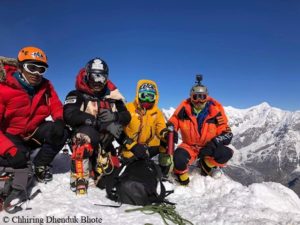
But Purja did not only make headlines with his ascents. On Annapurna, he belonged to the Nepalese who laid the fixed ropes up to the summit. Then he took part in the rescue of the Malaysian mountaineer Wui Kin Chin. Nims and the other rescuers managed to bring Chin from over 7,000 meters from the mountain, but he died a few days later in a hospital in Singapore. On Dhaulagiri, Purja and his companions were the only climbers to reach the summit this spring – despite bad weather. On Kangchenjunga, Nims tried to rescue two Indian climbers who, completely exhausted, had run out of oxygen when they descended. Both died. Most of the headlines, however, were brought to the former soldier of the British Gurkha regiment by the photo he took on 22 May on the summit ridge of Everest. The picture, which showed a long queue on the narrow ridge, went around the world.
Actually, Nims Purja wanted to be now already in Pakistan – for the second phase of his “14/7 Project Possible”: this summer he wants to scale the five eight-thousanders of Pakistan. But he had to postpone his departure because he still lacks money to continue his project. Nims has already taken out a second mortgage on his house in Great Britain. He collects donations via crowdfunding (anyone who wants to support him can do so here – click on the link!). I sent Purja some questions. Here are his answers.
Nims, you stood on the summit of six eight-thousanders in Nepal this spring and were right on schedule with your “Project Possible”. You had to fight the most on Dhaulagiri. How much risk did you have to take?
Continue reading “Nirmal Purja: “I still want to summit all Pakistani 8000ers before the end of July””Summer hustle and bustle on K2?
Little by little the expedition teams arrive in the north of Pakistan in order to tackle the country’s mountain giants this summer. According to US mountain blogger Alan Arnette, the government in Islamabad has issued almost 400 permits so far, including 164 for the Pakistani south side of K2, the second highest mountain in the world. For comparison: the Chinese authorities granted 142 permits for the northern side of Mount Everest in the past spring season.
A K2 permit for a five-member expedition team costs 12,000 dollars, i.e. 2,400 dollars per person. For every additional climber 3,000 dollars become due. Compared to Everest, this is almost a bargain: both on the Nepalese south side and on the Tibetan north side you pay 11,000 dollars per head, in Tibet it includes a garbage collection fee of 1,500 dollars.
Continue reading “Summer hustle and bustle on K2?”Ngima Nuru Sherpa: At work onto Everest record list
“It’s not my goal to chase the records,” says Ngima Nuru Sherpa. “Mount Everest is my job.” This spring, the 37-year-old from the village of Tesho near Namche Bazaar, the hub of the Khumbu region, reached once more the summit of Everest: “I’m the youngest till date to have been up there for the 22nd time.”
On 23 May, Ngima Nuru stood at the highest point at 8,850 meters after climbing via the Northeast Ridge. “This year there was more snow below the Advanced Base Camp than in 2018, but less snow above 7,900 meters,” the Sherpa writes to me adding that during the whole time it was very windy on the Tibetan north side: “At the North Col many tents were damaged, the wind blew some equipment off the mountain.”
Continue reading “Ngima Nuru Sherpa: At work onto Everest record list”Government of Nepal to investigate Everest deaths
“If a committee had been set up to create the world, it wouldn’t be ready today.” This realization, attributed to the Irish writer and politician George Bernhard Shaw (1856-1950), I had to think of when I read today that Nepal’s Prime Minister Khadga Prasad Sharma Oli has ordered the formation of an Everest committee of five. The members are to investigate the recent deaths on Mount Everest and review the existing guidelines for climbing the highest mountain on earth, Department of Tourism Director General Dandu Raj Sharma was quoted.
Continue reading “Government of Nepal to investigate Everest deaths”Revol used bottled oxygen on Everest
Elisabeth Revol is not one of those professional climber who constantly informs the public about their plans and then share their adventures in real time. When her sponsor Valandre announced on 23 May that the 39-year-old Frenchwoman had scaled Mount Everest without bottled oxygen, hardly anyone knew that she was on the highest mountain on earth. One day later she also reached the summit of Lhotse.
Last Saturday Valandre rowed back. Because Revol was already pre-acclimatized to an altitude of 8,400 meters, it had been “in error” assumed that she had not used bottled oxygen on Everest, the company said.
Continue reading “Revol used bottled oxygen on Everest”Lukas Furtenbach on Everest business: “It’s a rough market”
Becoming everybody’s darling is certainly not one of Lukas Furtenbach’s goals in life. The 41-year-old Austrian doesn’t mince his words when he represents his points of view. He does this offensively and is also not afraid to name names when he criticizes someone. It’s obvious that he doesn’t make only friends by this. Furtenbach polarizes.
Five years ago, Lukas founded his company “Furtenbach Adventures”. In 2018, the operator offered for the first time an “Everest Flash Expedition”. The concept: Everest in four weeks – through targeted preparation with a specially developed hypoxia training and system, more bottled oxygen than usual, more Sherpas. “I have been using and experimenting with hypoxia for almost 20 years,” says Lukas.
He scaled Cho Oyu in 2006 and Broad Peak in 2007. Furtenbach reached the summit of Everest twice: in 2016 via the south side – and this year via the north side. In the past season he started with two groups: a “classic” Everest expedition with seven members and a flash expedition with five clients – in addition the mountain guides Rupert Hauer and Luis Stitzinger, 21 Sherpas and himself. All of them reached the summit. After his return Lukas answered my questions.
Lukas, the situation on the south side of Mount Everest has been discussed for weeks, but hardly anyone talks about the north side. How did you experience the season there?
Continue reading “Lukas Furtenbach on Everest business: “It’s a rough market””Maurizio Folini: “A thank you from the rescued is the most beautiful appreciation”
Secret heroes. There are players on Mount Everest that everyone knows and appreciates, but hardly anyone talks about. Like the “Icefall Doctors”, those highly specialized Sherpas who year after year set up the route through the dangerous Khumbu Icefall and maintain it throughout the season. Or Maurizio Folini and Lakpa Norbu Sherpa, who fly up the Everest slopes with their red-white-blue painted “Kailash” helicopter whenever it is necessary to bring down climbers who have got into trouble or died. The 53-year-old Italian and the 38-year-old Nepalese have long been a well-rehearsed team. Also in the past season they did most rescue flights together.
Maurizio has been flying regularly in the Himalayas since 2011. Lakpa Norbu was trained as a helicopter rescuer in Switzerland. He is a true specialist when it comes to transporting injured, sick or even dead people on the long line. Maurizio Folini took the time to answer my questions after his return from the Himalayas. I appreciate that, because Maurizio rarely has time. Meanwhile he is flying in Switzerland again.
Maurizio, the Everest season is behind you. How many flying hours and how many rescue missions did you have?
Continue reading “Maurizio Folini: “A thank you from the rescued is the most beautiful appreciation””Dead climbers spotted in the Indian Himalayas
There is almost no hope to find the eight climbers alive who have been missing for days in the Indian Himalayas. Indian authorities announced that five bodies had been discovered by a rescue helicopter at an altitude of more than 5,000 meters. The bodies had been sighted in an area where a “huge avalanche” had gone down, it said. It was assumed that the five belonged to the missing group and that the other three climbers had also died in the area.
Continue reading “Dead climbers spotted in the Indian Himalayas”